
Covid-19: the benefits of flow chemistry & biocatalysis
Efficient and safe process design combining SEQENS technical capabilities:
Brilacidin as a case study
As already mentioned in our previous article (“Seqens biocatalytic approach to improve the synthesis of Danoprevir, a Covid-19 antiviral candidate“), an increasing number of synthetic small molecules are undergoing pre-clinical or clinical studies as potential candidates to develop a treatment against CoVid-19.
More than 100 of these targets were subjected to trials as of early May: some are already approved drugs being reevaluated in view to repositioning them, while others are still in the clinical phase for their initial indication. Different therapeutic strategies are being considered.
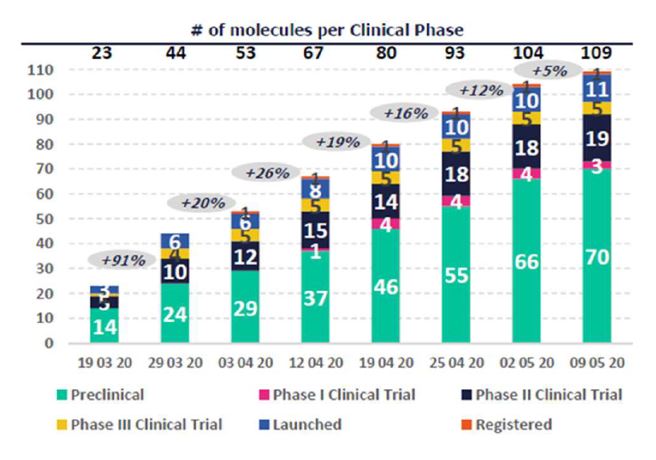
Some molecules – called antivirals – aim to prevent the virus from entering host lung cells or replicating by the action of protease or polymerase inhibitors, in order to block contamination and spread of the virus. Several candidates initially developed to address other viruses such as Influenza, Hepatitis, HIV, Ebola, Malaria, SARS or MERS, have been submitted for study. Favipiravir or Remdesivir are among the molecules tested.
Other drugs seek to limit the complications due to the development of CoVid-19 in affected patients. Certain ‘immunomodulatory candidate molecules’ seek to curb the now “famous” cytokine storm (a disproportionate inflammatory response linked to the release of an excess of protein, interleukin-6, which over-activates the immune response).
Anticoagulants, such as heparin, can be administered to reduce the potential risk of thrombosis or phlebitis that could develop in severe forms.
Finally, drugs – such as treatments for idiopathic pulmonary fibrosis – are also tested to protect the lungs and limit the phenomena of breathlessness or respiratory distress.
Pending the conclusions of clinical trials which will make it possible to define a drug specifically adapted to this virus, care is being taken to limit the pain of patients: paracetamol is used to limit headaches or sore throats in mild cases, antibiotics for more serious cases, sometimes also, in palliative care, anxiolytics to limit respiratory distress.

Brilacidin, a drug candidate for COVID-19 treatment
Brilacidin is a case study that is particularly illustrative of the repositioning strategies implemented to identify an appropriate treatment. This synthetic molecule, discovered by ‘PolyMedix’ and currently under development by the American company Innovation Pharmaceuticals Inc., is a new generation antibiotic, a non peptidic molecule which mimics the structure of defensin, a category of host defense peptides. This drug candidate has been evaluated for its immune/antiinflammatory and anti-microbial properties. Several Phase 2 clinical trials have already been conducted in humans, targeting oral mucositis, ulcerative colitis or acute bacterial skin infections, thus making it possible to aggregate a large amount of data on the toxicological profile of this product.
Regarded by Innovation Pharmaceuticals Inc. as a drug candidate with a broad therapeutic profile, Brilacidin is now undergoing new in vitro studies, conducted at a U.S.- based Regional Biocontainment Laboratory (RBL), to evaluate its antiviral activity against SARS-CoV-2, as well as its potential to inhibit the excess of cytokines such as interleukin-6. While the results of the clinical trials are critical to the fate of the candidates being studied by drug developers such as Innovation Pharmaceuticals Inc., it is equally critical to develop, since the earliest stages of development, a robust and competitive chemical synthesis process to anticipate large-scale production if successful and plan marketing needs.
The aryl diamide symmetric structure of Brilacidin is built around a pyrimidine dicarboxylic acid core. The main disconnection, the 2 amide bonds around this simple diacid, requires the building block 1, a chiral aryl-cycloalkyl ether which arises itself respectively from the building blocks 2 and 3.
Building block 2: using flow chemistry to design and master a safe nitration process
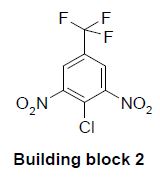
The chloro-dinitro aryl derivative is prepared by di-nitration of 4- chlorobenzotrifluoride, a reaction involving highly reactive, corrosive and dangerous reagents, namely a mixture of sulfuric acid and nitric acid. The reaction experimental conditions must be perfectly controlled to avoid any runaway of the reaction.
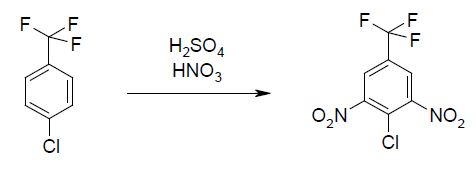
To address safety concerns, flow chemistry could be implemented to potentially scale-down the reaction size and limit the amounts of highly reactive reagents compared to a fed batch reaction. The fine-tuning of the addition of the reagents and the starting material could make the continuous production of the target product possible, as we exemplified it already on other dinitrocompounds. Generally, flow processes proceed with higher purity, lower by-product formation and a better control of the critical process parameters compared to batch.
The quantity of unstable reaction mixture in the continuous reactor at a given time is greatly reduced compared to a conventional batch process, thereby reducing safety risks. The surface/volume ratio is also much more favorable, allowing a better control of the reaction temperature and exothermicity, and a safer operation process.
Flow chemistry is also characterized by a gain (better yield) in chemical efficiency: continuous plug flow or stirred-tank cascades of reactors allow a tighter residence time distribution than batch, and in many cases a better selectivity.
Finally, fine-tuning the addition of the reagents and starting material contribute to minimizing secondary reactions and the formation of impurities: the quality of the products is correspondingly improved, reducing the environmental footprint of such processes.
Building block 3: asymmetric synthesis using an alcohol dehydrogenase
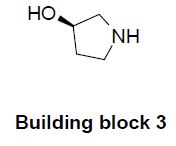
The chiral 3-hydroxy pyrrolidine derivative, part of the chiral ether, is prepared by the asymmetric reduction of N-Boc 3- pyrrolidinone. Among the methodologies that mediate such a reduction of ketones, the famous Corey-Bakshi-Shibata (CBS) reaction allows for the reduction of complex ketones with good enantioselectivity. However, the chiral induction relies on the use of a chiral oxazaborolidine catalyst that requires several synthetic steps to be produced and is operated at low temperature. On the other hand, this kind of targeted reduction is known to be efficiently catalyzed by alcohol dehydrogenases.

This NAD(P)-dependent family of enzymes can oxidize alcohols into carbonyl compounds and can also reduce ketones into chiral alcohols. Generally, the ADH-catalyzed reductions proceed with high enantioselectivity in mild conditions. An efficient system for the regeneration of the NAD(P)H cofactor could be easily implemented to afford a greener process. Furthermore, this biocatalytic reduction surrogate should allow for the reduction of the cost of the transformation first because enantioselectivity relies on the enzyme and not on a chiral and costly catalyst, tedious to synthesize. Secondly, the reaction is run in water at room temperature making the use of enzymes robust and more environment friendly compared to a chemical process that relies on watersensitive reagents and generally requires low temperatures to ensure a smooth reaction and good enantioselectivity.
This family of enzymes (alcohol reductases) is now part of Seqenzym®, enzyme kits proposed by ‘Protéus by Seqens’ for fast assessment of enzymes on a target reaction.
Combining Seqens capabilities for safer and more efficient drug synthesis
This Brilacidin synthesis pathway overview, illustrates the key contribution of process engineering and key competencies such as Biocatalysis and Flow chemistry to secure and optimize manufacturing processes.
More than 35% of FDA approved drugs need at least one nitration step in their manufacturing process, and about 20% a fluorination step, to mention only these two typical chemical function and atom. Their implementation in synthetic organic molecules are often characterized by exothermicity, and sometimes the energetic or unstable nature of the reagents involved and isolated intermediates. Largely inspired by the large-scale processes used in petrochemicals and/or specialty chemistry, Flow chemistry is now part of the CDMO landscape and considered as an essential technology asset for controlling sensitive chemical reactions.
The key to mastering flow chemistry processes is to combine expertise in chemistry and process engineering. Seqens benefits from a long experience in Flow chemical and process engineers have been designing, optimizing, and operating continuous processes for decades, whether on large scale building blocks or on active pharmaceutical ingredients (A.P.I.’s), such as GMP-grade salicylic acid.
Our R&D Center, Seqens Lab, in Porcheville (France), is equipped with continuous bench reactors and analytical tools for appropriate data acquisition. In order to complete its toolbox, Seqens Lab will be equipped at the end of 2020 with a new GMP pilot flow equipment devices able to host at least nitration, diazotation or halogenation type of reactions, and to produce representative precommercial batches up to ton scale.
Additionally, biocatalysis steps are developed by Seqens, using a robust methodology for biocatalytic process development. With 20 years of experience, our affiliate ‘Protéus by Seqens’ has developed an integrated platform for the identification of the best candidate enzyme comprising enzyme kits for fast screening (Seqenzym®), a library of >1000 sequenced strains from diverse origins giving access to 3 million exclusive enzymes, as well proprietary directed evolution technologies.
Flow chemistry & Biocatalysis
These flexible tools enable to increase process robustness, improve economics and accelerate scale-up and industrialization steps of several drug candidates. Apart from Brilacidin, several other drugs under clinical trials for CoVid-19 treatment require many exothermic chemistry steps and/or highly selective synthetic steps. Both topics can be efficiently addressed today; they benefit of such appropriate technologies in order to reach more and more valuable synthetic molecules needed to control our main diseases as CoViD- 19’s one.
Seqens teams reviewed more than a hundred small molecules, and are ready to handle their development and industrialization, according to their stage of development. This race against time for the identification and development of a molecule against COVID19 is essential while awaiting the development of a vaccine. Thanks to its positioning in the drug value chain, Seqens is fully mobilized to bring its expertise and support pharmaceutical companies and emerging companies in their search for a treatment and in the production of APIs and pharma intermediates.
Authors :
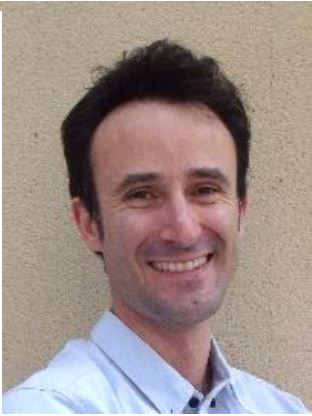
Project Manager,
Protéus by Seqens, Seqens

Business Development Manager,
R&D Services, Seqens
More information about Proteus: www.proteus.seqens.com